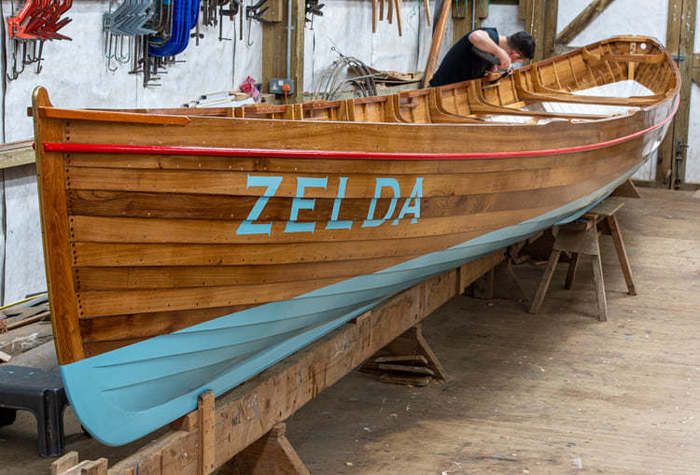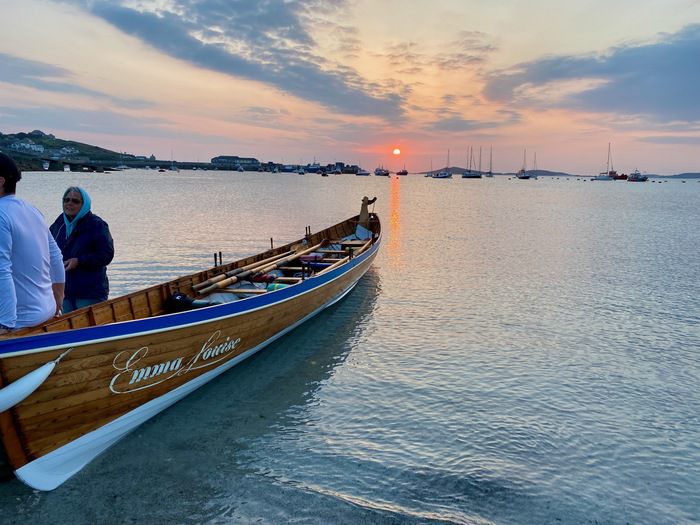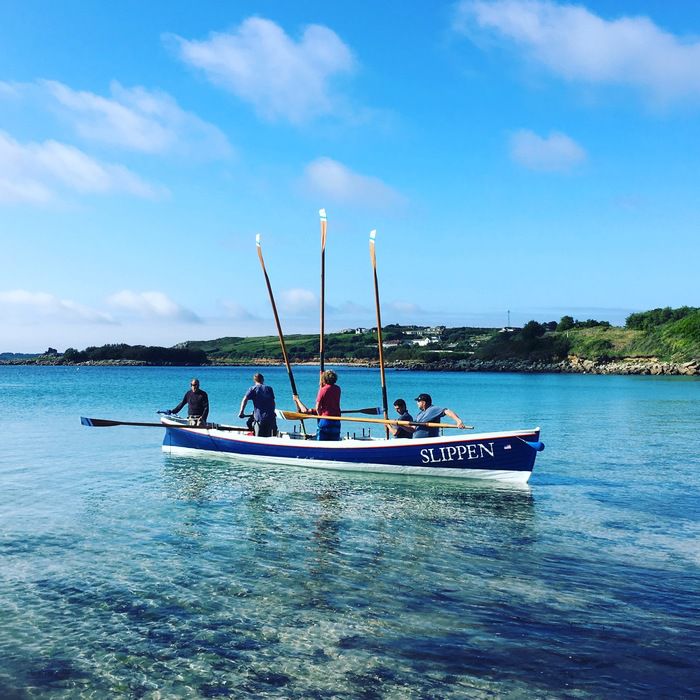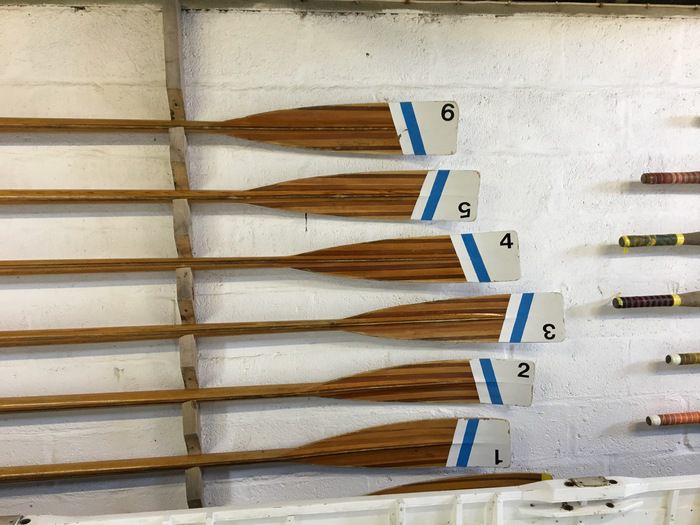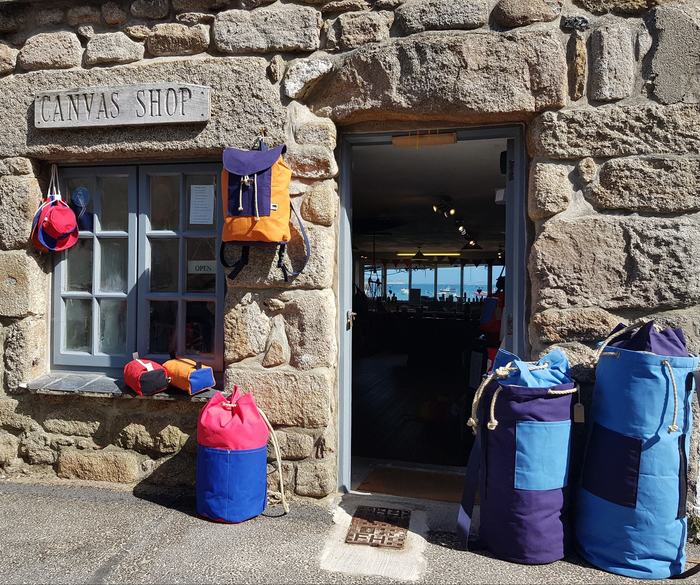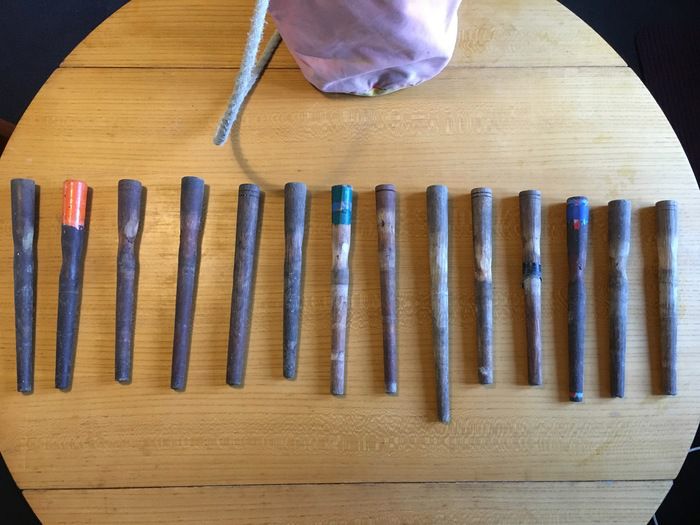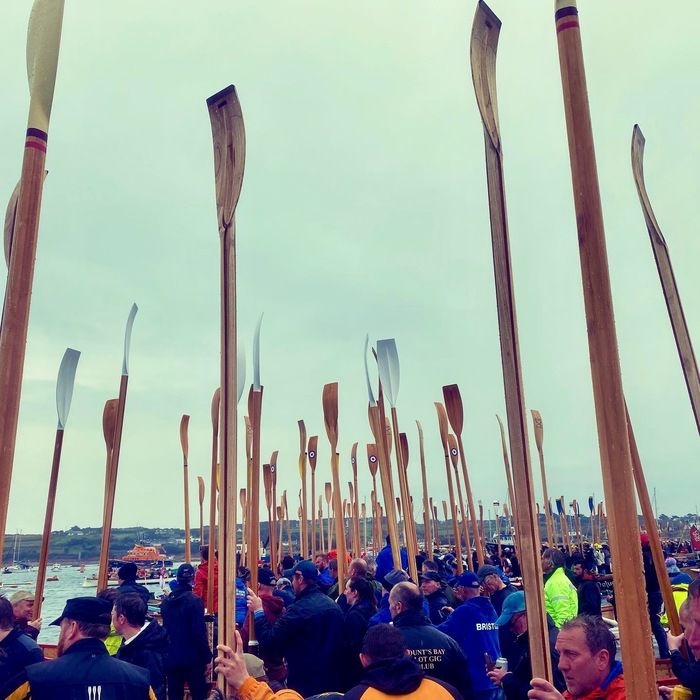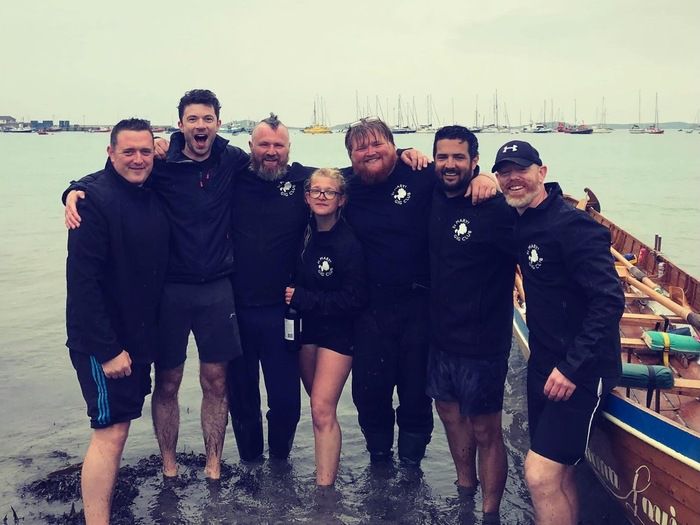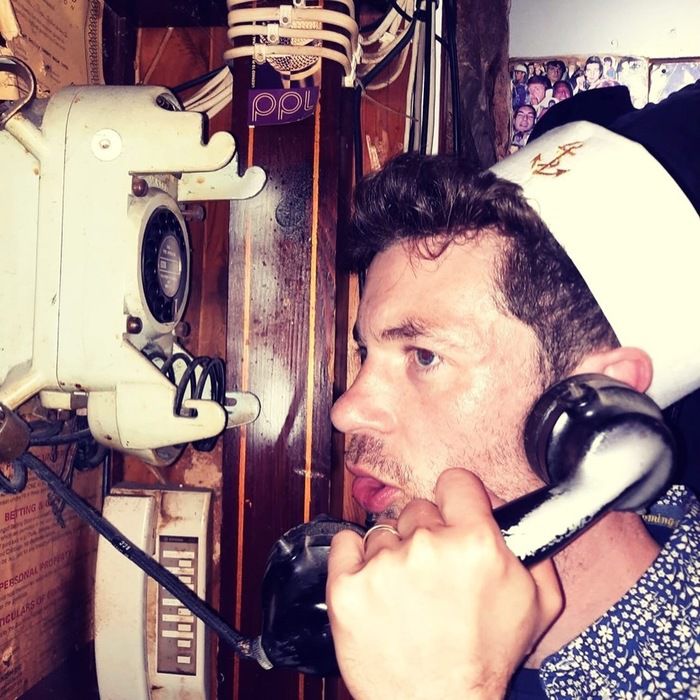Rowing antiques in paradise: the 2022 World Pilot Gig Championships
The colourful, charismatic and sea drenched World Pilot Gig Championships takes place annually over the May Day bank holiday weekend on the Isles of Scilly, England’s most southerly point and home to its highest concentration of beaches from which to launch rowing boats (probably). This year is the 31st WPGC, April 29 to May 1 2022, the first since 2019 with a reduced capacity of 120 gigs, down from the record 160+ gigs1 in the last event due to capacity and safety as opposed to plague or declining popularity.
For 3 days, the streets of Hugh Town, St Mary’s, are heaving with boats on trailers, crews making preparations and spectators searching for a good vantage point. The water is the scene of intense competition between rowers from across southern England and some of the rest of the globe. The islands’ supermarket, an excellent little Coop, is a bottleneck for the crowds, a lesson in patience and humility, a conveyor belt of port, bananas and despair. I experienced it all from the number 5 seat in a crew taking part in the men’s open competition, supported by 2 vikings, 1 wizard, 1 male model, a Rubenesque strong man, and a hummingbird.
Saturday 30 April #
For the uninitiated, the weekend is built around the men’s and women’s open competitions which each comprise 4 races: the big race from St Agnes to St Mary’s (featuring all crews) followed by 3 group races.2
Our first race is at 2pm on Saturday afternoon. Each member of the crew has spent the morning doing his or her own thing, but we all keep in regular contact via the group chat. The morning’s main topic of conversation is what time we should meet up. There’s enthusiastic debate on the issue until eventually it is concluded we will meet an hour before the race, the exact amount of time we always meet before every race. With this ritual observed and the morning now gone, I get my stuff together and head out the house, excited and curious about how we’ll perform having practiced just once as a full crew.
I ride my bike past Old Town Bay on the way into town and there’s no sign of a large sporting event. The sleepy harbour is as empty and calm as ever, a happy mixture of Cornwall and Corfu. Today is particularly idyllic: some old ladies sip tea and admire the cold turquoise water; children chase around the sand and splash in the sea, all crocs and nets and non-sequiturs. Hugh Town, just a couple of minutes ride away, is heaving by contrast. The Strand, a promenade overlooking St Mary’s harbour, is filled with hundreds of rowers, preparing their gigs for the big race. There’s a hustle and seriousness about the more professional crews, rushing to get their last bits of kit together, take on fluids and find a toilet. Others busy themselves with face paint and costumes, bleary eyed from cheering on the vets the day before.
By the time I join my crew at the gig sheds on Porthmellon, the women’s race has just finished and they are dabbling into the beach. There’s much discussion of where their crews placed as we help them lift gigs, move kit and get prepared to swap into their boats. Our boat, somewhat miraculously, is Emma Louise, one of Scilly’s few modern racing spec boats and a gig that we are not usually suffered to touch let alone race in. But this year is special because it has seen the completion of a new gig - Zelda - a beautiful boat, built here on St Mary’s by Andrew Hicks just in time for champs. The St Mary’s A crew is given the honour and advantage of rowing Zelda, which leaves Tregarthen’s for the B crew and Emma Louise for us.
Perhaps one day I’ll get to try Zelda, but Emma Louise is the very best gig I have rowed so far. It was built 18 years ago in 2004 by Peter Martin (and named after the daughter of John Heywood, the person who bought it for the islands). I suppose it would be considered mature by those competing at the sharp end of the competition, but gigs age very well indeed. They are enchanting, fairytale objects with different personalities and whimsical names like Czar, Golden Eagle, Nornour, Serica and Galatea. Some are impossibly old with long romantic existences saving lives, recovering treasure and smuggling wine from France. All modern racing gigs are based on the design of Treffry, a boat constructed in 1838 and still raced in Newquay. Bonnet and Slippen, two of Scilly’s gigs, are even more ancient, both being built in 1830, a time when Charles Darwin was only contemplating a trip on the Beagle and Earl (‘tea’) Grey was Prime Minister. Emma Lou has a long life to look forward to.
As we row out to the start line at St Agnes, Bethan, our cox, gives instructions and details on all the goings on around gig weekend, far better informed than any of us despite having only been back on the islands for a couple of days. She’s coxing two crews and rowing in the women’s open event, but still has an unnatural level of nervous energy. Stu and I talk her through our crew’s various quirks, one of which is to host a 5 stone sandbag on the bow side of the boat, a necessary addition we think in order to balance out our collective 105 stone weight. She takes it all in, whilst keeping everyone in time and texting to keep track of the bewildering number of commitments she’s made.
It’s around 20 minutes of rowing before we join the other crews at the start line next to St Agnes. We have by this point decanted our sand baby into a friend’s RIB, employing instead some strategic shuffling and leaning around the boat to reduce our natural slant towards bow side. Looking around, I can’t discern a start line. Bethan seems to know where we are, but to my eyes the boats are scattered randomly and it feels far from crowded even though we know there are a hundred other crews plus support vessels bobbing around. The WPGC is curiously invisible to spectators, with most vantage points on St Mary’s offering little more than an impressionistic blur.
After 10 minutes or so of dabbling and chatting, the starter begins to issue instructions. His sheer, insistent voice comes loudly through Bethan’s radio. The tension increases. In no time at all, we’re removing layers of clothing and getting psyched for the race whilst listening intently to Bethan as she manoeuvres Emma Lou to a clear starting position. It gets noisy as the other crews do the same. Coxes arguing with one another and chastising their crews.
One minute to go.
All gigs are in position. Cross the line now and you’re disqualified and out of the party. Some crews sit close to it; others hang back.
“Up half.” says Bethan. We all take a small stroke. The 10 second countdown begins. We’re forward and ready…
“Go!” shouts Bethan. And so it begins. One long slow stroke. Four punchy strokes all on the arms. Then into our normal rate and length. It’s a great start.
Now we can see the competition. Gigs are everywhere. Coxes screaming at each other, calling for water so their crews have space. Paddles clash. Gigs in front, behind and to both sides. I have no idea where we’re at, but we’re in the thick of it and Bethan guides us one gig at a time, one target at a time, through the melee.
As we approach the Newman we know we’re getting close to the finish line at St Mary’s quay and the whole field begins to converge. That’s when the sheer number of gigs reveals itself to you and the brutal pace begins to really hurt - nothing like a training session. The atmosphere pushes you on, the crew doesn’t want to cede position to anyone and the cox is driving us to chase the boats ahead. We’re nearly there and then. Stop.
We run out of room on the finish line - everyone is furious with… Islander - one of the St Mary’s gigs with a mainland crew - stopped right in our way. Then we realise something’s wrong. A member of their crew is on his back motionless. Stu is a paramedic and immediately understands what’s happened as does the support boat which is straight on the scene. We need to get him into their boat. We shout at one of their rowers who is understandably shocked - we shout again to make him take a paddle so we can pull closer. Stu jumps straight in and takes control of the situation.
Suffice to say the unfortunate rower got help quickly and made a full recovery.
Race 2 is later the same day at 5pm, a 10 minute row from nut rock into St Mary’s. Everyone is feeling better now and a little happier with our result earlier in the day: fiftieth place. As we line up at the start line we look around at our group E competition and everyone gets a sense that we might do okay, that we might be a bit too good for this group. Our start is amazing, head boat immediately. Bethan keeps an eye on us - giving us breaks together and then pushing together. Every push takes us clear of the pack and we know nobody has it in them to go past us. We win the group easily and are promoted to group D. Into the top 48.
About gigs and rowing #
On paper, the WPGC is a rowing regatta, which conjures images, in my mind at least, of skinny boats, striped club blazers and Pimm’s addled spectators. This is undoubtedly an unfair caricature of all regattas and it is a million miles away from gig weekend. As a sport, pilot gig racing, retains a connection to its practical origins in the days before sonar, GPS and other navigational aids, when gigs and their crews played a vital role in mitigating the risk to large ships full of goods and passengers. Between Scilly and Cornwall and the ports beyond lies a treacherous maze of hidden sand bars and granite. The only reliable way of avoiding these hazards was to employ someone with local knowledge - a ‘pilot’ - to show you the way. On spotting a ship approaching the islands, crews would race to get their respective pilots to the ship first. The winner could then negotiate a fee to guide the ship to its destination port. It’s easy to be skeptical as to how often events ever conspired to allow full blown races to occur, but this was a time when boats were everywhere and central to the economy, an endless stream of opportunities to supplement the income of islanders.
There’s an authenticity to gigs, which is part of the attraction. They are, competent ocean-going vessels - substantial objects, which makes them sturdy in rough seas but heavy at around 350kg or anywhere up to half a tonne for the older, soggier vessels. Cornish Pilot Gig Association specifications dictate that new gigs must be 32 feet (9.8m) long, 4 feet 10 inches (147cm) at the widest point and constructed using elm. The oars are similarly chunky, over 12 feet (3.5+ metres) long, made of spruce and fairly heavy at around 10 pounds (4.5Kg).
A typical Olympic rowing boat is literally a shell by comparison, built of super light carbon fibre and employing innovations such as sliding seats to allow the full use of leg compression and ‘riggers,’ the metal projections which provide a fulcrum for the oars enabling the width of the boat’s hull to shrink to comically narrow proportions, often as little as 2 feet (60cm) and weighing less than 100kg for boats of more than 60 feet (over 18m) in length.
A pilot gig crew is made up of 7 people with 3 rowers on each side plus a coxswain sitting at the back (the stern) who steers the boat using ropes attached to the rudder. Each rower has a single paddle (so called ‘sweep’ rowing as opposed to the 2 paddled ‘skulling’) and sits on a fixed plank, with feet pushing against a wooden bar called a stretcher. The oars pivot between wooden dowels in the side of the boat known as pins. The pins are replaceable and weaker than the boat to ensure that particularly large stresses snap the pin and not the gig.
The fixed wooden planks are not particularly comfortable to row on, especially when trying to make the most of your leg muscles, it therefore pays to have some protection. Gig seats are the solution - they are satisfying chunky objects, rectangular prisms of foam wrapped in canvas or PVC, in vivid colours. Be apprised that there’s only one place to buy a gig seat on Scilly and it’s more marvellous than the objects it sells. A small canvas shop hidden away in Hugh Town, Ratbags makes everything from clothes and bags, to chairs and pencil cases. Every wall covered in the tough, brightly coloured material used in their products. The craftspeople look out over St Mary’s harbour, working on their creations as you decide which seat will protect your behind from a season of racing. Buying your first seat is like buying a wand from Ollivanders.
The principle of rowing is simple: grip the oar with your hands a couple of hand-widths apart; lean forward with straight arms; drop the blade into the water just below the surface; lean back keeping the arms locked and pull the handle into your chest for the end of the stroke. It sounds easy, but there’s plenty of room to mess up. When I first learned to row, my primary motivation to improve technique had less to do with any sense of fulfilment or the performance of the crew, than simply avoiding the humiliation of ‘catching a crab’. The phrase evokes Disney-like images of scooping singing crustaceans from the water, but the truth is less fun. Catching a crab happens when the top of your oar’s blade is tilted backwards relative to the bottom, forcing the oar to dive down into the water as you pull the stroke. It’s strangely panic-inducing. All of a sudden you feel the paddle being sucked under the water and you’re fighting the momentum of the entire boat. The only options are to either lift the paddle up by the handle or break a pin. Either way, you’re not rowing anymore, the boat begins to stall and the rhythm is lost by your crew (who now hate you). You must desperately fumble around for a replacement pin or heave the oar back into place. All the while, you’re losing ground to other boats.
I have caught plenty of crabs and broken many pins during my few years of rowing, though fortunately never in a race. One slight upside is you get to keep the broken pin and they’re rather splendid. Our crew inherited a bag of pins, each one a different shape and colour and of unknown origin. Some (the best ones) are dark and hard with tight grain, others light and soft. There are fat pins that barely fit in the holes and long, slender ones worn smooth with years of grease and relentless impact and friction. (And, yes, all gig terminology is basically just erotic innuendo).
Sunday 1 May #
Race 3 takes place on Sunday morning at 11:45am. Despite my best efforts to spoil things, nobody in the crew went out drinking the night before. Instead we spent our evening eating and recovering, poring over the drone and boat footage from GigRower (a new addition for this champs), texting each other and marvelling at our performance in the victorious group race. There’s a new found belief and enjoyment in our rowing. We’re not quite as grumpy or jaded as usual. It’s a good sign.
I have dressed carefully for the morning’s race in an attempt to protect a large weeping sore that has developed on my bum. The injury, I conclude, is probably down to my very old gig seat which has somehow acquired the frictional properties of a stretch of tarmac. A replacement seat, large plaster and layering of pants, swimming trunks and shorts is my solution.
Fully gusseted, I get into town early so I can grab a coffee and walk up to the sheds. The women’s crews have already set off for their races so it’s strangely quiet on Town Beach. I notice a single men’s crew practicing in the harbour. The boat - a pretty varnished thing - moves surprisingly quickly, springing forward with each pull on the long oars, followed by a lazy return and satisfying momentum. Each stroke punctuated with a dull, rhythmic clunk that echoes across the bay. It is a joy to watch.
After an hour or so, the crew is back together and we swap with the women ready to head up towards the start line for our race from nut rock. There’s a lot of hanging around in group races as you wait for the slower heats to go first - we spend the time chatting and looking at the other gigs, rowing every now and then to try and keep our muscles warm. As we dabble around waiting for the group D race to start, we row past the St Mary’s B crew who are in the B group (top 24). Hayden shouts to them, “see you in group C!” We laugh heartily; they laugh heartily. It is, after all, a joke.
Until it isn’t. When it’s finally our turn to race, we get another amazing start. Bethan talks us through the race with what little voice she has left - resting us and pushing when needed. We’re leading most the way and by the end we slip just behind into second place but well clear of the rest of the group. “You’re going up!” Shouts Bethan. We keep rowing, desperate not to mess up this chance. “Ease off, you’re going up.” The race is over. We’ve come second in group D. We are promoted. The B crew come last in group B. They are demoted. We will race together in group C for the final race. Without wishing to exaggerate, it is unquestionably the greatest moment in our lives and in the history of gig rowing.
Securing group C for the final race means that our worst possible finishing position is 36th. Perhaps we’ll beat a gig or two and creep a bit further up, but that is as much as we can hope for. And so it proves. Later that afternoon we heave across the line to complete our fourth and final race of the men’s open event - last place in group C, 36th in the WPGC (B crew showing their class by winning the group - 25th place - well done lads!), the tanks are empty but everyone is satisfied that we’ve clawed our way back from total mediocrity. Jumping two groups is not easy and it feels like the best we could have achieved. For everyone but Derek, it is the best we have ever achieved.
It’s cold now and raining steadily, but nobody wants to go anywhere. Tradition dictates that all of the boats raft up together next to the quay in St Mary’s harbour to wait for the group A race to finish and cheer on the winners. Every crew raises paddles in honour of the new champions, each rower standing to attention, oar in one hand, can of beer in the other, a bottle of port making its way up and down the boat. Eventually Currah’s Pride (Looe Rowing Club) crosses the line as champions. Scilly’s A crew come an excellent fourth and the competition comes to an end for another year. It’s time to go back to the sheds and for the party to start. The gigs are pushed apart and all crews dabble away, and merge with the steady train of boats navigating the traffic of the harbour on their way back to town beach or Porthellon.
As a correspondent of this year’s World Pilot Gig Championships, it would be remiss of me not to provide a list of winners. The following crews are the best in the world.
Women’s Open
Q, Fowey Gig Club
(Zelda, St Mary’s Gig Club, came 12th)
Womens Vets
Zelda, St Mary’s Gig Club
Women Super Vets
Ictis, Mounts Bay Pilot Gig Club
Men’s Open
Currah’s Pride, Looe Rowing Club
(Zelda, St Mary’s Gig Club, came 4th)
Men’s Vets
Ann Glanville, Caradon Gig Club
(Tregarthens, St Mary’s Gig Club, came 2nd)
Mens Super Vets
An Dhowrlann, Caradon Gig Club
Après row #
With the rowing out the way, we are free to drink and be merry. Beer at the sheds, banana rum and singing on the beach, pasties and ale at the brewery. Everyone is happy and having fun. Competitors go to great lengths to get to Scilly, enduring make-shift sleeping arrangements, huge expense and a long journey. The attraction is clear: expert crews rub shoulders with novices; young compete against old; differently abled across the board. There are no invitations, no pre-qualifications, everyone in theory is in with a chance. Everyone and everything is focussed on rowing. The remoteness of the islands forces competitors to stay together in and out of the water - it is a captive audience. The islands become a festival of rowing and these enthusiastic visitors make the place feel new and exciting.
Everyone has their favourite place to be on the Sunday night of gig weekend and there aren’t any bad options. I suppose my favourite place is the Mermaid. We arrive there after various meanderings around Hugh Town. The pub is packed with rowers, giddy at being together, being on Scilly. Some with medals, others in fancy dress, singing loudly, drinking freely, dancing everywhere from the bar to the labyrinthine, Escher-like corridors which lead to the toilets. The staff dispense drinks in time to the music, keeping up with the endless demand through a sort of focussed cognitive flow state. The air is thick with beer vapour, sweat and Bon Jovi. It is the perfect place to end champs.
Then it’s onto bank holiday Monday. An exquisite headache consumes me; the world is a cubist nightmare. Eventually, inevitably the call of the crew and many lost possessions brings me back to the pub - to the Atlantic and then back to the Mermaid. The unsettling curative properties of more alcohol. Smiles everywhere despite the farewell sight of mainland gigs on trailers; gigs in blankets, waiting to go home.
Fin #
When I moved to Scilly, a moment’s reflection persuaded me that I probably wouldn’t row: crews must be hard to get into, there will be limited spaces available, tests of proficiency in the water, questions over poor fitness and physical strength, not to mention impenetrable cliques and tedious rules. Ultimately, inevitably, I did end up in a gig. The truth is that if you’re keen, available and have a pulse, you stand a fairly good chance of finding your way into a crew. What’s more, it’s just as easy to find your way into (and become a correspondent of) gig rowing’s marquee event. I’m pleased I did. On a small island, the sea is everywhere and dictates everything. Rowing dissolves the barrier. No engine, no fuel, no moorings, no breakdowns, just a boat and some muscle and someone to guide you. It is liberating.
There’s also something of the exotic about it all. It feels like I’m in an episode of Trans World Sport, part of my regular Saturday morning TV diet as a child. It was a weekly roundup of news and profiles from sports you’ve never heard of in beautiful, remote or obscure locations around the globe: a sprawling favela, a Mongolian grassland, wrestling in the desert, a concrete tennis court in roasting Los Angeles. Places I could only dream of. It was a window into other worlds, a small dose of human geography within the underfunded education system of 1990s Newcastle. Rowing ancient boats in a distant archipelago, even one in the British Isles, would have seemed just as remote and alluring to my eyes. Something I’d never do, somewhere I’d never go.
But I am here. Ready and waiting to smuggle wine from France. Rowing in champs, rowing under the stars, rowing between secret islands. Rowing antiques in paradise.
-
This years women’s open competition had the highest number of entrants with 115 crews starting the St Agnes race; 106 crews started the men’s event. In 2019 there were 163 finishers in the women’s event and 160 in the men’s. ↩
-
Your finishing position in the Agnes race determines your group for race 2, group A containing the best crews with the slower boats in groups further down the alphabet. There are 12 boats in each group and if you finish in the top 2 in your second race you are promoted; the bottom 2 are relegated. The same happens in race 3 and then race 4 is a competition to see where you come in whatever group you ended up in. It’s all very complicated and not something that should ever be set out in prose. You have my apologies. ↩

